#Niche market audience engagement
Explore tagged Tumblr posts
Text
Leveraging Influencer Marketing for Small Businesses
In today’s fast-paced digital world, small businesses in Australia face the challenge of getting noticed and connecting with their audience. But, there’s a strong solution – using influencer marketing. I’ve seen firsthand how working with the right influencers can boost a small business’s growth and visibility1. Influencer marketing means teaming up with people who have a big and loyal following…
#Authentic brand endorsements#Community-driven content creation#Influencer marketing ROI#Micro-influencer partnerships#Niche market audience engagement#Small business influencer collaborations#Social media influencer tactics#User-generated content strategies#Word-of-mouth advertising
0 notes
Text
How to Find Clients Starts by Understanding Who You Serve
Struggling to find the right clients? You’re not alone. If your ideal customers seem just out of reach, it’s time to rethink your strategy. Discover the solution in my latest blog! #MarketingSolutions #BusinessGrowth #freecontent
How to Find ClientsStarts with Understanding Who You Serve Written By: that Hannah Jones Time to Read: 6 minutes Finding clients for your business is a lot like embarking on a journey. You need a map, a destination, and a solid understanding of who you’re inviting along for the ride. It all starts with one crucial question: Who is it that you serve? Who does your product work for? Who gains…
#audience analysis#branding strategy#business development#Business Growth#business management#client acquisition#client outreach#Content marketing#customer engagement#customer journey#customer loyalty#customer needs#customer persona#digital marketing#Finding clients#free marketing guide#growth hacking#ideal client profile#inbound marketing#lead generation#market research#marketing strategy#networking#niche market#online marketing#organic marketing#sales funnel#Social Media Marketing#strategic planning#targeted marketing
1 note
·
View note
Text
#micro-influencers#niche audiences#growing impact#authentic engagement#brand trust#influencer marketing
0 notes
Text
How to Make Money on YouTube in the UK
YouTube has become a viable career for many around the world, and the United Kingdom is no exception. Aspiring content creators in the UK have the opportunity to turn their passion into profit. But how exactly does one go about making money on YouTube in the UK? I use VidIQ to maximise my channel growth. It has helped me grow from 12K subscriber to over 50K since 2021! Let’s explore the key…
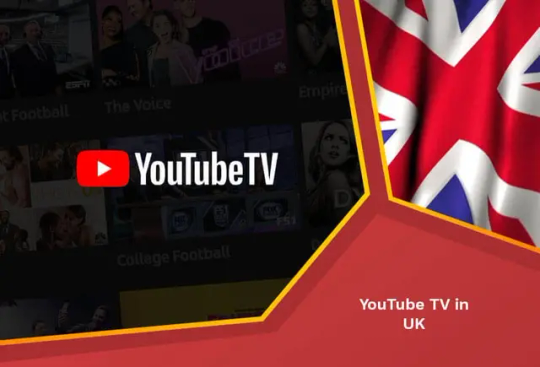
View On WordPress
#adsense#affiliate marketing#Audience engagement#audience retention#beauty & fashion vlogging#brand sponsorship#channel memberships#channel optimization#collaboration#content creation#copyright policies#educational content#gaming channels#influencer marketing#monetization#music channels#Niche Content#social media promotion#subscriber growth#super chat#UK YouTubers#video advertising#video analytics#video editing#video marketing in the UK#video monetization guidelines#video seo#Video Thumbnails#video views#viral videos
0 notes
Text
MARKETING CASE STUDY: COMPLEX MARKETING PROMOTION IN COMPETITIVE PLUMBING NICHE

The plumbing industry is a vital sector that caters to essential water supply, drainage, and sanitation needs. It operates within a competitive niche, where companies strive to establish their presence and capture market share. This case study explores the complex marketing promotion strategies employed by a successful plumbing business. Throughout its operation, this company has achieved its goals. However, the competition is fierce, with well-established companies boasting strong reputations and substantial budgets. Despite starting with only three trucks, our client has experienced remarkable growth, expanding their fleet to over ten trucks. In the past three years, they have consistently doubled their profits annually by offering plumbing services and responding promptly to service calls.
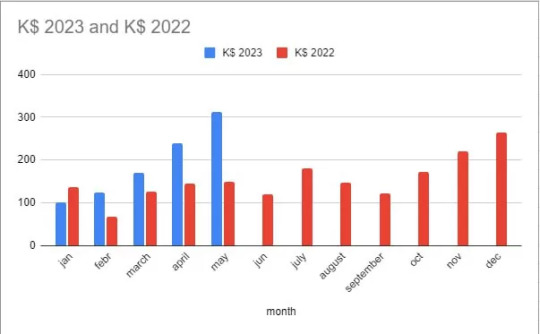
MARKETING CHALLENGES IN THE PLUMBING NICHE

One of the key marketing challenges faced in the plumbing industry is the localized nature of business operations. Companies are often restricted to advertising within the areas where they operate. This limitation on geo-targeting options restricts their ability to expand into other markets. Since plumbing services are primarily service-oriented, it is crucial for businesses to maintain a strong local presence. Additionally, the plumbing niche deals with a “hot” customer base, where clients require immediate solutions. This poses a challenge in capturing and converting customers swiftly. The target audience consists of individuals seeking services “here and now,” necessitating adjustments in the advertising approach to effectively cater to their urgent needs.
MARKETING STRATEGY AND OBJECTIVES
The company’s marketing objectives in the competitive plumbing niche are focused on successful and repeat sales, as well as conversions, particularly inbound calls and inquiries. Rather than simply aiming for broad reach or website views, the company places emphasis on identifying the specific sources from which leads originate. To overcome marketing challenges, a comprehensive strategy was implemented to establish a strong presence across various niches where customers seek plumbing services. This involved maximizing visibility on relevant social media platforms, with a particular focus on local business platforms such as Google My Business, YELP, and NextDoor. The marketing team diligently tracked and analyzed the effectiveness of every lead source, strengthening the resources that proved to be most successful.
Target Audience and Customer Segmentation
In this niche, the company did not have a specific target audience in terms of demographics or psychographics. The potential clients for plumbing services could be anyone residing in a house or apartment. However, a segment of the target audience included companies involved in real estate operations, rentals, and commercial real estate. This encompasses a wide range of businesses, including those in the restaurant industry and other small businesses. By utilizing channels such as YouTube, social media marketing (SMM), search engine optimization (SEO), and pay-per-click (PPC) advertising, the marketing strategy is designed to reach and engage both residential and commercial customers effectively, capturing their attention and driving conversions.
Learn how to find your target audience and effectively promote your business in a competitive niche by visiting our blog: How to find a target audience for your business.
RESULTS AND ACHIEVEMENTS
The implementation of the marketing strategy in the competitive plumbing niche was accompanied by diligent measurement and tracking of marketing performance and results.
The organic website traffic also exhibited positive growth, with 90 monthly visits in 2021, reaching 330 monthly visits in 2022. For the first five months of 2023, the website received an average of 437 monthly visits.
Sales directly attributed to marketing promotion displayed a notable increase, with 600 thousand generated in 2022 at an average of 50 thousand per month. In the first five months of 2023, sales amounted to 425 thousand, averaging 85 thousand per month.
The number of incoming targeted calls lasting more than 30 seconds also showed positive trends, with 2,209 calls in 2022 (184 per month) and 1,473 calls for the first five months of 2023 (294 per month). Additionally, 834 incoming calls were specifically attributed to Google My Business (GMB) and social media marketing (SMM) in 2022, while 774 calls were recorded for the first five months of 2023.
The return on marketing investment (ROMI) currently stands at an impressive 300%, reflecting the direct sales generated from the marketing promotion efforts.
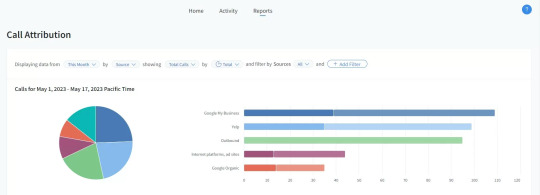
LESSONS LEARNED AND RECOMMENDATIONS
Through a comprehensive analysis of the marketing campaign and key metrics, valuable insights have been gained for future marketing strategies in the competitive plumbing niche. The analysis revealed that SEO optimization proved to be the strongest channel, providing a high return on investment despite its relatively low cost. On the other hand, Google Ads showed weaknesses, attracting spam and yielding poor results.
In light of these findings, we recommend to focus on localized promotion strategies for a local business like plumbing. Understanding the preferences and behaviors of the target audience, including personal networks, friends, and neighbors, can provide valuable insights into effective marketing approaches. Additionally, it is crucial to closely monitor and evaluate traffic sources to ensure they align with the areas where the company’s services are available. This will help avoid investing resources in areas that do not yield meaningful results. It is essential to continually refine and optimize the marketing strategy based on the performance analysis of different channels. This includes reallocating resources to strengthen the most effective channels, such as SEO, while considering alternative advertising avenues that may better suit the nature of the plumbing industry. By leveraging these lessons learned and recommendations, future marketing strategies can be tailored to achieve maximum impact and drive sustained growth in the competitive plumbing niche.

CONCLUSION
In conclusion, the case study findings demonstrate the importance of effective marketing in the competitive plumbing industry. By implementing a targeted approach and leveraging platforms such as Google My Business, YELP, and NextDoor, the company successfully established a strong presence in the local market. The emphasis on SEO optimization proved to be a cost-effective strategy, driving organic website traffic and contributing to revenue growth. The analysis highlighted the need for localized promotion and understanding customer preferences. Overall, effective marketing played a crucial role in overcoming challenges and driving success in the competitive plumbing niche.
HOW TO PROMOTE YOUR BUSINESS IN COMPETITIVE NICHE – CALL IM4U AGENCY

Ready to promote your business in a competitive niche? Take the next step and call IM4U Agency today. Our expert team specializes in crafting effective marketing strategies tailored to your industry. Let us help you navigate the challenges, stand out from the competition, and achieve your business goals. Contact us now and unlock the potential of your brand in the competitive landscape.
Oleksandr Yaremenko
#marketing case study#Complex marketing promotion#Competitive plumbing niche#plumbing industry#marketing strategies#advertising campaigns#target audience#digital marketing#brand positioning#market analysis#competitive advantage#conversion rates#lead generation#customer engagement#social media marketing
0 notes
Text
Monetize Your Blog: The Top Strategies for Affiliate Marketing
Looking to monetize your blog? Affiliate marketing might be just what you need! Check out these top strategies to maximize your earnings and boost your online presence. Start earning more today! #affiliateMarketing #monetizeYourBlog #digitalMarketing
Introduction Understanding Affiliate Marketing Choosing the Right Affiliate Products Creating Quality Content Types of Content that Work Well for Affiliate Marketing Tips for Writing Quality Content Building an Email List Why You Need an Email List How to Build an Email ListHow to Choose the Right Affiliate ProductsHow to Promote Affiliate ProductsHow to Track Your Affiliate Marketing…

View On WordPress
#affiliate links#Affiliate marketing#affiliate marketing blog#affiliate marketing courses#affiliate marketing examples#affiliate marketing for beginners#affiliate marketing niche#affiliate marketing programs#affiliate marketing strategies#affiliate marketing tips#affiliate marketing tools#affiliate marketing trends#affiliate marketing websites#affiliate networks#audience engagement#content creation#conversion rate#CTR#Digital marketing#email marketing#Landing pages#monetize blog#online business#online marketing#opt-in forms#passive income#product reviews#social media marketing#tracking metrics
0 notes
Text
Maki money
#I can give you some tips on how to create a successful money-making:#Choose a profitable niche: Start by selecting a niche that has the potential to generate revenue. For example#finance#business#health and fitness#technology#and personal development are popular niches that attract advertisers and sponsorships.#Create high-quality content: Produce original#valuable#and engaging content that resonates with your target audience. This will help you attract and retain readers and establish your authority i#Monetize your blog: You can monetize your blog in several ways#including affiliate marketing#sponsored content#display advertising#and selling digital or physical products. Experiment with different monetization strategies to see what works best for your blog and audien#Build an email list: Use your blog to collect email addresses from your readers and build a loyal audience. This will allow you to communic#Promote your blog: Use social media#SEO#guest posting#and other tactics to drive traffic to your blog and increase your visibility online. The more people who discover your blog#the more potential you have to make money.#bio.link/mdzakir
1 note
·
View note
Text
Discover Your Niche
The Secret to Unlocking Success and Engagement The world of writing is vast and varied, with countless topics and genres to explore. From the enchanting realms of fiction to the informative depths of non-fiction, writers have a wealth of opportunities to express their creativity and knowledge. However, one secret to unlocking success and engagement in this competitive landscape is finding your…

View On WordPress
#Engagement#Niche#Niche Market#Specialization#storytelling#Target Audience#Writing process#Writing Success#Writing tips
0 notes
Note
Writing an oc that's a streamer?
Writing Notes: Streamer Characters
Live Streamer
Also livestreamer or online streamer
Someone who makes videos that show them playing computer games, talking about products, or doing other activities, and streams them (i.e., puts them on the internet) at the same time as they are being made.
An individual who broadcasts real-time video content over the internet, engaging with an audience through online platforms.
Transmits live or on-demand audio or video content while users listen or watch.
Livestreams are deployed over various platforms, including social media platforms like YouTube Live, Facebook Live, Twitter, Instagram Live, and TikTok, as well as through professional business services, such as Kaltura and Dacast.
Unlike pre-recorded videos, live streams occur in the moment, allowing viewers to interact with the streamer through chat functions and other interactive features.
This immediacy creates a dynamic and engaging experience for both the streamer and the audience.
Live streamers cover a wide range of content:
playing video games,
hosting talk shows,
conducting interviews,
cooking,
crafting, and
live vlogging daily activities.
The versatility of live streaming content means that streamers can find their niche and build a community around shared interests.
Successful live streamers often cultivate a loyal following by maintaining a consistent streaming schedule, engaging directly with their viewers, and creating a sense of community.
What your Character does as a Live Streamer
Content Creation: Live streamers plan, prepare, and execute engaging live broadcasts. They choose topics or activities that resonate with their audience, maintain a consistent streaming schedule, and ensure that their content is entertaining and relevant to their viewers.
Audience Interaction: Interacting with viewers in real-time is a key responsibility. Streamers engage through live chat, responding to comments, questions, and feedback during the stream. They foster a sense of community by acknowledging and involving their audience, using interactive features like polls, Q&A sessions, and shout-outs to enhance viewer engagement.
Technical Management: Managing technical aspects is crucial to a successful stream. This includes setting up and maintaining streaming equipment such as cameras, microphones, lighting, and streaming software. Streamers must ensure a stable internet connection, troubleshoot technical issues promptly, and optimize stream quality to deliver a seamless viewing experience.
Monetization: Monetizing their channels is an important aspect for many streamers. This can involve receiving viewer donations, earning subscriptions (e.g., Twitch subscriptions), securing sponsorships and partnerships with brands, and generating revenue through advertising. Streamers may also leverage merchandise sales, affiliate marketing, or exclusive content to diversify their income streams.
Community Building: Building and nurturing a community around their content is essential. Streamers cultivate a loyal following by creating a welcoming environment, engaging with viewers regularly, and participating in community events or collaborations. They may also moderate chat and ensure a positive and inclusive atmosphere during streams.
Continuous Improvement: Successful streamers constantly strive to improve their content and grow their audience. They analyze viewer analytics to understand audience preferences and trends, experiment with new content formats or streaming techniques, and stay updated with industry trends and platform changes to maintain relevance and competitiveness in the streaming space.
What Type of Live Streamer is your Character?
Live streamers can be categorized into various types based on the content they stream and the communities they engage with. Here are some common types:
Gaming Streamers: Gaming streamers focus on playing and broadcasting video games live to their audience. They may specialize in specific genres such as first-person shooters, role-playing games, or multiplayer online battle arenas (MOBAs). Gaming streamers entertain viewers with their gameplay skills, commentary, and interactions with their audience through live chat.
IRL (In Real Life) Streamers: IRL streamers share their real-life experiences and activities in real-time. They broadcast everyday activities such as traveling, exploring new places, attending events, or participating in challenges. IRL streamers often engage their audience by interacting with them while showcasing their daily routines or special events happening in their lives.
Talk Show and Podcast Streamers: Talk show and podcast streamers host live discussions, interviews, or debates on various topics of interest. They invite guests or panelists to join their streams, engaging with them and their audience through insightful conversations and debates. Talk show streamers may cover topics ranging from politics and current events to pop culture and entertainment.
Creative Streamers: Creative streamers focus on showcasing their artistic talents and skills live. They create art, music, crafts, or digital designs while interacting with their audience. Creative streamers often provide tutorials, share their creative process, and take viewer suggestions or requests for their next project.
Music Streamers: Music streamers perform live music sessions, DJ sets, or music production sessions for their audience. They may cover popular songs, perform original compositions, or engage in interactive music creation with their viewers. Music streamers often use platforms that allow them to receive song requests and interact with their audience in real-time.
Fitness and Sports Streamers: Fitness and sports streamers broadcast live workouts, training sessions, or sports events. They provide exercise routines, fitness tips, and motivation to their audience while demonstrating exercises or participating in sports activities. Fitness streamers may also engage in challenges or competitions with their viewers.
Educational Streamers: Educational streamers conduct live tutorials, lectures, or workshops on topics such as science, technology, languages, or academic subjects. They share knowledge, answer viewer questions in real-time, and provide interactive learning experiences through demonstrations or experiments.
Cooking Streamers: Cooking streamers broadcast live cooking sessions where they prepare recipes, share cooking tips, and engage with their audience while demonstrating culinary techniques. They may also take viewer suggestions for recipes or cooking challenges, creating a community around food and culinary arts.
What Would your Character's Workplace Look Like?
The workplace of a live streamer is typically centered around creating a conducive environment for broadcasting engaging and interactive content.
Unlike traditional office settings, live streamers often work from home or a dedicated studio space that they have set up for streaming purposes.
This space is vital for maintaining control over the streaming setup and creating a comfortable atmosphere conducive to content creation.
At home, live streamers often have a designated area or room where they set up their streaming equipment.
This might include a high-quality camera, microphone, lighting rigs, and a powerful computer or gaming console capable of handling streaming software and gameplay simultaneously.
The setup is tailored to their specific streaming needs, ensuring optimal audiovisual quality and reliability during broadcasts.
Beyond the physical setup, the digital workspace of a live streamer involves managing streaming software, interacting with viewers through chat functions, and monitoring analytics in real-time.
This requires multitasking skills to engage with the audience while focusing on gameplay, discussion topics, or other content being streamed.
Streamers also use this digital space to collaborate with moderators, manage community interactions, and coordinate special events or collaborations with other content creators.
Some Streaming Strategies your Character Could Use
Makes their livestream unique
Focuses on their livestream audience’s needs
Surprises their livestream audience
Promotes their livestream
Interacts with their viewers
Tells viewers what to do at the end of a livestream (e.g., see more content, attend an event)
Sources: 1 2 3 4 5 ⚜ More: Writing Notes & References
Hope this helps with your writing!
#streamer#writing reference#writeblr#writing notes#literature#writers on tumblr#dark academia#spilled ink#writing prompt#light academia#creative writing#character building#character development#writing resources
77 notes
·
View notes
Note
I love your versions of the decepticons but I do have a question! I honestly love tarn and his brooding nature, so I wanted to know what happened to him? Why’s his face absolutely destroyed and why does he hate megatron,,?
hey, that’s a good question! I believe I’ve answered something similar in the past re: Tarn’s deal, but I can rephrase it again+give some additional context below the cut!
Tarn and Megatron have a very similar background. Both come from low-caste professions (Megatron, obviously, a miner, and Tarn a construction hauler) and both became gladiators to an impressive degree of celebrity. Tarn was an artist in his own right, being a musician and composer (which wasn’t as broadly commercially appealing as Megatron’s writer-artist repertoire, but certainly attracted its fans).
On Cybertron, gladiators have their own sort of “stardom.” Regular audiences aren’t just invested in the sport, but the story behind it, and so the performers become “characters” in themselves. Established fighters often have a dedicated fanbase, lore, and even “managers” or “agents” to manage that public persona. These “careers” can be lucrative, but, unsurprisingly, very brief.



In his heyday, Tarn was everything the gladiator celebrity complex favors: young, charismatic, attractive, skilled, and, above all, marketable. The music he made enhanced his character, and, in turn, his gladiatorial feats promoted his music. He found a degree of purpose in his popularity.
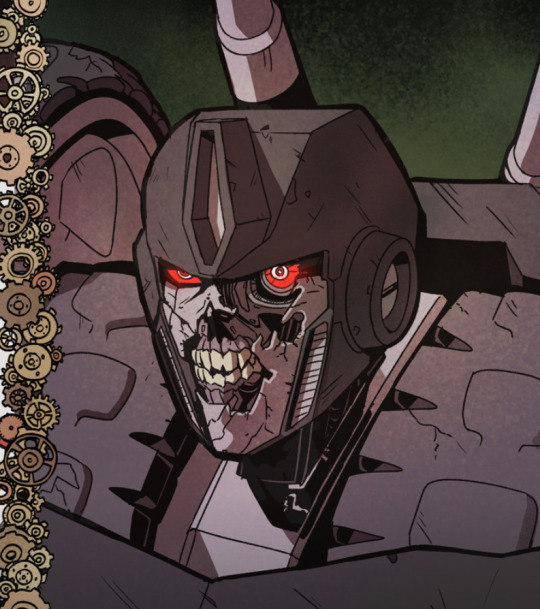
Tarn’s era of celebrity ended when, in his closest match, he lost his face. He survived, but this spoiling took away the foremost aspect of his fame—his identity (in the past I’ve talked about the culture around faces and their irreplaceability, which applies here). Having no choice but to wear a pit mask to protect his exposed interior, he gradually faded out of popularity, in favor of the new wave of rising stars. Over time his music lost its audience and he became cemented in the second rate.


When Megatronus came along, she was quick to gain notoriety for the same reasons Tarn had, with a very similar audience. It was almost natural that she would fill the same niche, with a similar backstory, skillset, and audience appeal. Tarn immediately became jealous, but also couldn’t resist the familiar pull of a world he’d been unceremoniously excommunicated from: in Megatron, he found a way to live vicariously, and quickly began to see her as some parallel proxy for his lost ambitions. All gladiator friendships are underscored by a sort of tired acceptance of impending doom, but, in Tarn’s case, he abused their gallows goodwill to be an extremely two-faced fairweather friend.


Though they certainly shared some traits, Megatron and Tarn were notably different. Where Tarn found earnest purpose in his success, Megatron resented her popularity, engaging with her high society pass with cynical disdain. She invited scandal and scorned the whole scheme until she could use it to get what she wanted. Tarn frequently scolded her for her shallowness, but envied her and the attention she received immensely. This resentment only ever festered and grew.
Internally, Tarn’s wish has always been to witness Megatron’s downfall, and to indulge in her suffering. As his proxy, he will only ever be satisfied to know that she is more miserable than him. The only things preventing him from killing or hurting her directly were his deep desire to live her life, and his own utter hollowness and insecurity.
154 notes
·
View notes
Note
any tips for getting into copywriting?
Learn the basics of copywriting & writing fundamentals/ marketing skills
Study the different types of copywriting (web/banners, email, social, ads, direct mail, sales letters, etc.)
Decide on your niche(s). Study everything you can about the industry, trends, latest news, customer demographics/psychographics, customer behavior, types of lifestyles/preferences they have, how they speak, where they spend the most time (IRL or digitally)
Craft an inspiration folder full of compelling copywriting examples you find when browsing on the web, going through your email, scrolling on social media, billboards, magazines, direct mail, etc.
Practice rewriting these examples with your own flair. Evaluate it, and keep practicing until you're proud of your copy.
Be as concise, clever, and convincing as possible. Keep your tone conversational (write like how you would speak), catchy, simple, and witty. Take out any extraneous or fluff words. Pepper in cultural references, puns, and relatable anecdotes understood by your target audience when relevant to your messaging/CTA
Create a portfolio with these mock-ups or projects done for family/friends (state they're spec work, not client-commissioned samples) or clips from an internship, school work, etc.
Craft a USP for yourself (including your niche, copywriting specialties, and the specific expertise you offer within your broader niche/service offerings that makes you unique)
Create an Upwork profile and share your services on LinkedIn (optimize both of these profiles)
Research local clients and small businesses within your niche. Also, take time to create a list of dream clients. Study their copy, brand voice, and keep tabs on updates regarding these companies' happenings
Learn the art of a cold email/LinkedIn pitch/Upwork proposal. Introduce yourself and your services to your prospect and share with them how you can fulfill a specific need they're seeking out (For local and smaller companies, feel free to offer suggestions. With more established companies, connect the dots as to why your experience/expertise is a great fit for their brand/target audience), and attach your work/link to your LinkedIn profile, website, and any other relevant hub for your professional services & content
Ask for referrals from friends/family to get started. If they're not a relative, get a testimonial to include in your portfolio
Follow up once if you haven't heard back from a prospective client after an initial pitch after a few days
Search for potential gigs on sites like Upwork/ProBlogger/People Per Hour
Once you land a gig, execute to the best of your ability and hand in your work by the deadline (strategies surrounding best business practices is a whole other post, lol)
Gather testimonials from all clients of successful projects. Confirm with clients whether you can use their work in your portfolio if you're unsure
Continue studying copywriting from books, courses, and everyday reading & living
Stay knowledgeable about advancements/updates in your field, keep updated on current events, and culture/social trends, and read a lot in general. Have interesting, multi-faceted conversations with others. Observe what makes people tick & remain engaged in a verbal dialogue or content
#copywriting#creative writing#women writers#writers on tumblr#writeblr#copy writing#female entrepreneurs#successhabits#skill building#writing skills#marketing tips#business tips#women business#glow up tips#level up journey#entreprenuership#success habits#study tips#creative process#creative practice#communication skills#career options#career advice#professionalism#networking#femmefatalevibe
193 notes
·
View notes
Text
What's going to happen is that 'fame' and 'celebrity' the way we think of it will be further democratized but also.. gatekept. As in.. it's going to become a niche to be super rich and invested in the super rich opposed to it being a mass spectacle. I think people will get so turned off by the ostentatiousness of it that they're only going to care about rich people if they're genuinely interesting. It'll be out of place unless you're putting it to good use. And anyone who's into fame for fame's sake as an audience will have that be a niche interest.
The uber famous will be an interest opposed to a goal. Leo shifting to Aquarius.
It's what I felt would be the best tactical business move for Kim and her SKIMS brand because of its loaded Scorpio Rising w/ placements there. For a while, companies have believed that attempting to hit the zenith point of mass appeal. They've done that through broadening a niche market best case scenario where its seams breaking allow for new customers to flood it through interest/curiosity (often caused by virality). Like with what happened to Stanley cups.
But for many brands, artists, and entertainers/influencers, mass appeal will be read as ingenuine or insincere to many people.
Because when you attempt to appeal to everyone, you run the risk of your message seeming contrived opposed to universal. We're tired of performative sincerity because we know that it's honest when it isn't trying or expected to do well. Fake news and stories were always abundant but in the era of quick-to-publish content creation where personal stories (exacerbated by GRWM tales and drama) aren't intimately shared anecdotes anymore but are engagement farming strategies we're now seeing through, our distrust in the media is more resentful now than ever. Especially when you include the propaganda pushed by Pa|estine's co|onizers that younger generations have been primed through years of media ingenuity and cleverness being how millennials, z, and alpha communicate to one another. You can't trick us in our own house.
What'll rise out of all of this will be the rebirth of small and intimate communities that individuals will thrive in. And any 'fame' that results in a mass effect will appeal to that individuality within us all. Especially to those who've felt pushed to the margins, rejected, left behind or not taken seriously, discarded, abandoned.
This is the era of the Reject and Special Interest. But the former must believe in themselves to take advantage of it. You are never rejected without your permission.
42 notes
·
View notes
Text
Maxwell Tani at Semafor:
Soon after Vice President Kamala Harris became the Democratic nominee, deputy campaign manager Rob Flaherty turned his attention to sports. The campaign needed to introduce Harris quickly to people who aren’t obsessed with politics. Sports is perhaps America’s last remaining monoculture, and Flaherty and the Harris team decided to book her on sports shows and podcasts. But one by one, the biggest personalities and shows politely turned them down. “Sports and culture have sort of merged together, and as sports and culture became more publicly and sort of natively associated with this Trump-conservative set of values, it got more complicated for athletes to come out in favor of us,” Flaherty, 33, told me in an interview last week. “It got more complicated for sports personalities to take us on their shows because they didn’t want to ‘do politics.’” “That’s not to say Steph Curry and Steve Kerr and LeBron [James] and all them coming out wasn’t impactful or important,” he said. “It was more impactful because it had gotten so much harder. But certainly the culture that has been associated with heavy sports-watching has become associated with right-wing culture in a way that makes it harder for us to reach people.”
Flaherty declined to say who turned Harris down, but she didn’t appear on key shows hosted by sports figures sympathetic to Democrats, like Colin Cowherd, Bill Simmons, or the Kelce brothers. (As Semafor first reported at the time, Harris did appear on All The Smoke, a popular but more niche basketball podcast, and NFL hall-of-famer Shannon Sharpe’s Club Shay Shay podcast.) The campaign’s failure to completely crack the sports sphere was, to Flaherty, ominous, and part of a larger trend in which some influencers who had felt comfortable engaging with the Biden White House, demurred when asked to help Harris make her case to their followers. “When it’s not cool to talk about politics,” he said, “you’re kind of afraid of the audience.” “Campaigns, in many ways, are last-mile marketers that exist on terrain that is set by culture, and the institutions by which Democrats have historically had the ability to influence culture are losing relevance,” he said. “You don’t get a national eight-point shift to the right without losing hold of culture.”
[...] Flaherty was also paying close attention to how the race was being run on the Republican side. Donald Trump was leaning into new podcasts, and his opponents were tapping a large network of right-leaning and conservative personalities to amplify their message.
Then, he acknowledged that the Republican Party had done a better job building up its alternative digital media ecosystem with podcasters, YouTube streamers, and friendly pundits. But he argued that the then-Biden campaign would overcome those obstacles by better navigating the “personalized internet,” by which sophisticated algorithms feed Americans highly specific information tailored to their tastes and online behavior. Speaking with me again last week, Flaherty said that remained their theory of the case the entire time. The campaign knew from the beginning that the race was going to come down to voters who do not pay attention to politics or mainstream news and instead get their information from people on YouTube, their friends’ Instagram stories, or links or memes dropped in a group chat. This firstly meant a shift in paid advertising from previous campaigns. Instead of just blanketing the airwaves in the battleground states, the campaign also invested heavily in ads on YouTube, recognizing the rapid growth in streaming. That’s where, the campaign’s data showed, many of Harris’ key voters were spending their time.
More importantly, this meant building out a strategy focused more on podcast appearances and interviews with influencers than on traditional media. Flaherty said the campaign skipped opportunities to talk to the major legacy news outlets because of Harris’ extremely limited time and its survey data, which showed that their audiences overwhelmingly supported Harris already. “There’s just no value — with respect to my colleagues in the mainstream press — in a general election, to speaking to the New York Times or speaking to the Washington Post, because those [readers] are already with us,” Flaherty said. Flaherty isn’t dismissive of television and other legacy media. “One of the most important moments of the campaign for the vice president was her interview with Bret Baier. That was a huge fundraising moment. It was a huge social moment,” he said.
“When Trump did the McDonald’s thing, it was smart, because it was a thing that obviously drove television coverage, but it also drove social media engagement too,” he said. “And those things often happen in tandem, but they don’t always, and so it was the sweet spot. It drove traditional coverage and nontraditional media. I don’t think TV is dead. It’s still probably the most important thing, but it’s the literal TV and what’s on it that matters.” As the campaign wore on, though, Flaherty said he realized their failure to gain traction in certain corners of media reflected a deeper problem — one that wasn’t solved when Harris replaced Biden on the ticket. The Harris campaign, representing what many voters saw as an embodiment of the status quo, was running contrary not just to ideological distrust of establishment figures but to media trends. The media successes of 2024 were independent, nontraditional online personalities who themselves were avatars of the rewards of going up against the Establishment.
Rob Flaherty, Kamala Harris’s digital campaign chief, told Semafor’s Maxwell Tani that the Democrats’ loss of hold on the culture played a big role into Donald Trump’s win.
#Rob Flaherty#Kamala Harris#Donald Trump#Podcasts#Streaming#Campaign Spending#2024 Presidential Election#2024 Elections
13 notes
·
View notes
Text
I know I put a lot of attention on Steam because of the sheer size of the marketplace and the effort Steam itself takes in marketing for devs but I really wanted to take a second to shout out TCM's numbers on itch.io because I really feel like the game found it's first platform there and I especially want to highlight what a great community it is for Indie Devs of all experience levels.
So I have TCM split up between 4 titles on itch- the main one is for all the new stuff and then each beta has it's own homepage. Downside, it kinda splits all my metrics up but the plus side its much easier to navigate for yall so I'll refrain from complaining lol.
Now given we started with just the Mori beta in late 2021, and added chapters slowly over time, here's where we're at right now.
Views: 312k
Downloads: 22.3k
Browser Plays: 35.6k
Ratings: 347
Collections: 5295
Comments: 189
So there are a couple really interesting things going on with this data. Let's analyze
Firstly, the numbers on the main chapter beat the *hell* out of the beta numbers. BUT this makes sense as more people are going to find the main game or PLAY the main game first at a vastly higher rate. So even though that game page has been up the least amount of time, it gets *by far* the most traffic. For example, if we take away the main page numbers, here's how the betas are doing on their own:
Views: 63.3k
Downloads: 5.4k
Browser Plays: 18.2k
Ratings: 133
Collections: 847
Comments: 42
So, if you were an indie dev posting your game on itch.io, these numbers should tell you to carefully consider how you're going to organize your game- especially if it comes in multiple parts. When I was going through the betas I did consider keeping everything on one page and therefore aggregating all of my traffic stats into one place but there are pros and cons.
Mostly, I went with separate pages because:
It's easier to organize files for downloads per character/game piece than to have a huge list of system-specific builds for every character that players have to scroll through. It's just hard to parse out.
Second, I thought that breaking up the chapters like this might help me better gauge each character's popularity via their stats. This... sort of worked. Because the Mori beta went up almost a year before Amir's, his numbers are MUCH higher and I have to be careful not to conflate that with his raw popularity. Another tricky note is that since Mori was the first chapter uploaded, many people will play his beta and then if they decide they're not into the game, won't play the other two characters, which again inflates Mori's numbers.
It was obvious in the gap after Spooktober 2021 and Amir's chapter that I had a project worth pursuing but the way I structured itch.io has made it hard to accurately gauge how popular exactly each character is.
Most of you know I'm running a popularity poll right now for some milestone art and while I expected Mori to lead (even with all the caveats I just listed, he does tend to be the most popular of the bunch) but I did not expect Akello to be *right* on his ass, even before weighing the patreon votes so.
Goes to show you that understanding structure and traffic trends can really go a very very long way to engaging your audience and build a stable, fun community around your game.
Another huge advantage to itch is that- in generalities- the community and ecosystem there is much kinder to beginner devs and passion projects. On steam, I'm taking up the same marketplace space as AAA multimillion-dollar games and while the eyeballs that comes with that is great for TCMs longevity hopefully, it also comes with the reality that I'm marking a queer niche adult visual novel right next to Mainstream Gamers. Now, I do want to be extremely clear that my experience with Steam so far has been really good- TCM has good and (more importantly) honest reviews, people have passed constructive critique to me and been extremely reasonable, I've managed to connect to some content curators who have similar tastes... But Steam is also the home to like. "Oooh Naur Woke Games Kill Art" Lists and stuff so. My experience on Itch is that- while some of that exists to a certain degree- the general ecosystem is much more forgiving and less sharply fractured.
I'm not sure that I would change anything I've done in the point leading me here so far, I think that by and large I've made the best choices I could given what I knew at the time and also managed to roll with the punches as the come but my experienced advice at this stage is definitely for an indie dev who hasn't landed a solid success yet or a hobby dev looking for feedback to start with Itch.io as a place to build your game's community.
There are other game hosting sites too, like Gamejolt, for instance, but while TCM used to be on Gamejolt their content policies and audience demographics were not a great fit, as was my experience with Newgrounds.
So. there are MANY choices but in all I'm grateful I didn't jump right into steam and also that my itch.io audience has been SO supportive and so enthusiastic about rating/commenting/and curating TCM to help spread the word. Especially since early in the project I had basically no marketing budget (I have a very small one now that covers the occasional blazed post but still).
ANYWAY thanks for reading my big dumb rambling posts but I really wanted to shed some light on the virtues of Itch after I've been chasing my own tail trying to get Steam working for me the way I want.
21 notes
·
View notes
Text
𝐆𝐫𝐨𝐰 𝐘𝐨𝐮𝐫 𝐒𝐨𝐜𝐢𝐚𝐥 𝐌𝐞𝐝𝐢𝐚 𝐏𝐫𝐨𝐟𝐢𝐥𝐞: 𝐒𝐭𝐚𝐧𝐝 𝐎𝐮𝐭 𝐢𝐧 𝐒𝐨𝐜𝐢𝐚𝐥 𝐌𝐞𝐝𝐢𝐚 𝐌𝐚𝐫𝐤𝐞𝐭𝐢𝐧𝐠
Want to grow your social media profile and make a lasting impact in the world of social media marketing? Start with these essentials: Define your niche, craft an eye-catching bio, and stay consistent with authentic, value-driven content. Optimize visuals, engage with your audience, and track your growth to see what works best. Don't just follow trends—make them work for you while staying true to your brand. Your social media profile isn’t just a page; it’s the face of your personal brand. Start building it today!
Also, you can follow: Facebook, Twitter, Pinterest
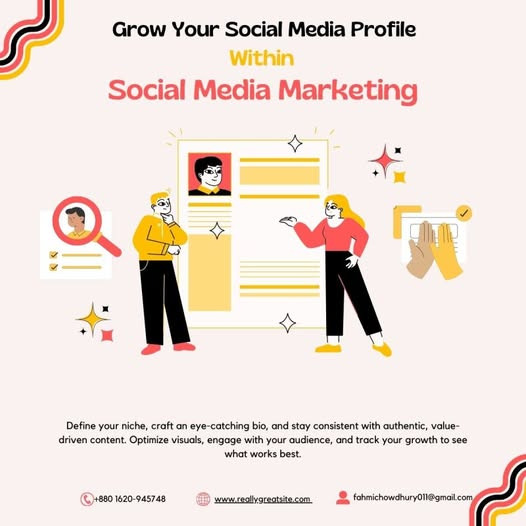
8 notes
·
View notes
Text
Yvette Heiser From Snapshots to Success: Wedding Photography Tips & Business-Boosting Strategies
Wedding photography is an art that goes beyond capturing moments – it encapsulates emotions, stories, and the essence of a couple's special day. However, mastering the craft of wedding photography and building a successful business around it requires a blend of artistic talent and strategic acumen.
Additionally, insights from Yvette Heiser: Strategies to Promote Your Photography Venture provide valuable guidance on marketing and promoting your photography business, offering a comprehensive approach to enhancing your business acumen and reaching a wider audience.

Capturing Everlasting Wedding Moments: Essential Tips
Preparation is Key: Familiarize yourself with the wedding venue beforehand to identify the best shooting locations and lighting conditions. Additionally, establish clear communication with the couple to understand their preferences and must-have shots.
Embrace Candid Shots: While posed portraits are essential, candid moments often hold the most emotional resonance. Capture the unscripted moments – a shared glance, a teary-eyed smile – to authentically convey the emotions of the day.
Leverage Natural Light: Opt for natural light whenever possible. It adds a soft, romantic quality to the images and minimizes the need for artificial lighting, allowing for more organic and intimate photographs.
Business-Boosting Strategies for Your Photography Venture
Craft a Compelling Portfolio: Curate a diverse portfolio showcasing your best wedding photography work. A visually captivating portfolio serves as a powerful marketing tool, attracting potential clients and setting you apart in a competitive market.
Leverage Social Media: Harness the potential of social media platforms to showcase your work, engage with your audience, and attract potential clients. Utilize platforms like Instagram, Pinterest, and Facebook to share your portfolio, behind-the-scenes insights, and client testimonials.
Build Strong Client Relationships: Prioritize exceptional customer service to foster long-term relationships with your clients. Word-of-mouth referrals are invaluable in the wedding industry, and satisfied clients can become your best advocates.
Nurturing Your Unique Style: Setting Yourself Apart
Develop a Signature Style: Cultivate a distinct aesthetic that sets your wedding photography apart. Whether it's a preference for black and white imagery, a penchant for capturing candid moments, or a focus on storytelling, a unique style can be a powerful differentiator in a crowded market.
Continual Learning and Growth: Stay updated with the latest trends and techniques in wedding photography. Attend workshops, seek mentorship, and engage with the photography community to continually refine your craft and stay ahead of the curve.
In conclusion, the journey from being a proficient wedding photographer to a successful entrepreneur requires a delicate balance of artistic prowess and business acumen. By integrating the timeless tips for capturing everlasting wedding moments with astute business strategies, including insights from Yvette Heiser – Exclusive Wedding Photography Tips to Capture Everlasting Moments you can elevate your wedding photography venture and carve a distinctive niche in the competitive industry.
Embrace the artistry, refine your business strategies, and watch your photography venture flourish as you preserve the timeless moments of countless couples' special days.
#yvette heiser#photographer#wedding#moments#camera#photography#pictures#childphotography#photographytips#events
20 notes
·
View notes